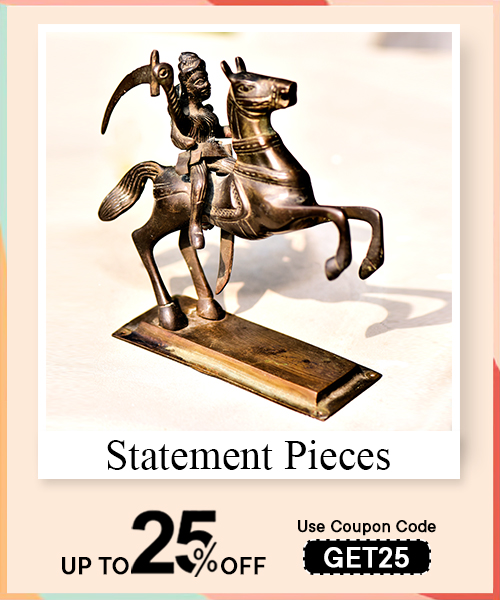Navratri is dedicated to Goddess Durga, the divine mother, and this festival spans ten days. Like previous years, Durga Puja will be filled with grand celebrations, religious offerings, and elaborate ceremonies.
The history of Kolkata Durga Puja can be traced back to ancient times. The festival's origins are in the Hindu epic, the Mahabharata. However, the famous mythological story associated with the Durga Puja festival is the victory of Goddess Durga over the buffalo demon Mahishasura.
According to this legend, the devil Mahishasura had received a boon from Lord Brahma, which made him quite solid and undefeated against all men and devas. He began to cause problems on Earth, threatening the existence of humanity and killing innocents.
The gods then decided to combine their divine powers and create Goddess Durga. After a fierce battle, Durga defeated and killed Mahishasura with her Trident, thus symbolizing the triumph of good over evil.
Read More : NINE FORMS OF GODDESS DURGA WORSHIP, RITUALS, AND CELEBRATIONS
Durga Puja is one of the most important festivals celebrated in West Bengal, Bihar, Assam, and Odisha. It is dedicated to worshipping the divine mother who symbolises power and victory of good over evil.
Over the centuries, Durga Puja has evolved as different rulers brought in their celebrations from other regions of India. The Durga Puja pandal gatherings have evolved into a grand public event, bringing together people from different social and cultural backgrounds. Here are some historical facts about the festival -
- During the mediaeval era, Durga Puja gained prominence in Bengal under the patronage of the ruling Hindu kings.
- During the Sena dynasty in the 12th century, Durga Puja started to be celebrated on a large scale.
- Kings like - Ballal Sena and Lakshman Sena were known for their grand festival celebrations.
- In the 19th century, Durga Puja witnessed a significant transformation under the influence of social and religious reformers like Ramakrishna Paramahamsa and Swami Vivekananda.
- The leaders focused on the spiritual aspects of the festival and its inclusive nature. The celebration of Durga Puja became an occasion for social unity and cultural integration.
- The Bengal Renaissance was a cultural and intellectual movement in the 19th and early 20th centuries.
- Scholars and writers of the time brought new ideas and artistic expressions into the festival. Elaborate and creative Durga Maa idols became a part of the celebration.
- During the British colonial era, Durga Puja underwent a significant transformation. The festival became a platform for nationalists and their hatred for the British Empire.
- Many social and cultural organisations started hosting public Durga Puja celebrations during the period.
- Such community-based celebrations are today an integral part of shaping Bengali identity and unity.
- Today, Durga Puja is celebrated with great zeal and enthusiasm across India. Thus, rituals, cultural programs, fairs and traditional food are now a core part of the festivities. The beautifully crafted idols, decorative lights, etc., impress all.

In 2025, Durga Puja will be celebrated from Sunday, September 28, to Thursday, October 2. This grand festival, one of the most significant in India, is observed with immense devotion, particularly in West Bengal, Assam, Odisha, and Tripura. Falling between September and October, it marks the beginning of the festive season according to the lunar calendar.
Durga Puja is more than just a festival; it is a celebration of culture, tradition, and spirituality. The festivities begin weeks in advance, with the construction of elaborate pandals—temporary structures where the idols of Goddess Durga and her children (Lakshmi, Saraswati, Kartikeya, and Ganesha) are placed and worshipped. These pandals, often adorned with stunning lights and unique artistic themes, attract thousands of visitors who come to offer prayers and seek blessings from Maa Durga.
The ten-day countdown to Durga Puja is filled with fasting, prayers, traditional music, dance performances, and cultural events. The streets come alive with vibrant processions, devotional songs, and artistic expressions that reflect the deep-rooted traditions of the festival.
On the final day, Vijaya Dashami, the beautifully crafted idols are immersed in water, symbolizing Goddess Durga’s return to her celestial home. This ritual marks the end of the celebrations, leaving behind memories of devotion, joy, and togetherness.
Read More : FASTING DURING CHAITRA NAVRATRI: SIGNIFICANCE AND GUIDELINES- SPECIAL FOODS AND DISHES PREPARED DURING NAVRATRI FASTING
The Durga Puja festival symbolises the victory of good over evil. The festival celebrates the Goddess's win over the buffalo demon Mahishasura. The Durga Puja signifies the defeat of negativity, ignorance and ego. It also reminds us that good deeds always win, even if demonic forces rule.
This festival also celebrates the divine feminine energy or Shakti. Goddess Durga forms the core of the Durga Puja images and greetings. She is worshipped as the giver of strength, courage and compassion. The festival highlights the importance of acknowledging and honouring the power and contributions of women in society. It serves as a source of inspiration for women and promotes gender empowerment.
The Durga Puja drawings are vital in shaping cultural identity and community unity. It has become the core attraction for national and international tourists.
The festival boosts a sense of brotherhood, peace and strengthens social bonds. Durga Puja pandals promote cultural growth and prosperity. The festival welcomes artisans, artisans and performers from various backgrounds to come together to create and showcase their talents. The elaborate pandals capture the hearts of all and serve as a local business booster.
The entire festival has a significant impact on the economy. This is because Durga Puja is known for its elaborate decorations, artistic pandals and beautifully crafted idols.
The festival provides an ideal and profitable platform for artists, artisans, painters, etc., to exhibit their skills and creativity. It boosts the local economy through increased tourism, business activities and the selling goods and services during the festive season. Durga Puja has become a significant source of livelihood for many individuals and societies.
The extraordinary artwork, quirky designs and lighting arrangements in pandals attract travellers to feel the day's significance. Durga Puja has become a meaningful basis for maintaining and promoting time-honoured Indian art forms. Such celebrations hence encourage social harmony, unity and understanding. The festival is not merely a religious function but a grand celebration. Hence, people of all faiths join the festivities, focus on their cultural significance and exchange greetings. It acts as a catalyst for community growth and cooperation.
Durga Puja is a time for spiritual reflection and personal growth. Devotees engage in prayers, fasting and religious rituals, seeking the blessings of the Goddess.
The festival encourages individuals to follow the path of courage, bravery and virtues. It also acts as a motivation to overcome the shortcomings. Thus, it helps to foster a deep connection with the Divine being. It is also an opportunity for self-improvement, renewal and spiritual growth. The festival is a vibrant and dynamic expression of faith, unity and integrity.
Read More : HAPPY DIWALI 2024: BEST WISHES, IMAGES, AND MESSAGES TO SHARE WITH YOUR LOVED ONES ON DEEPAVALI
Durga Puja celebrations have gained immense popularity over the years, not only in India but also worldwide. Several factors contribute to the widespread appeal and popularity of Durga Puja. Here are some key reasons-















